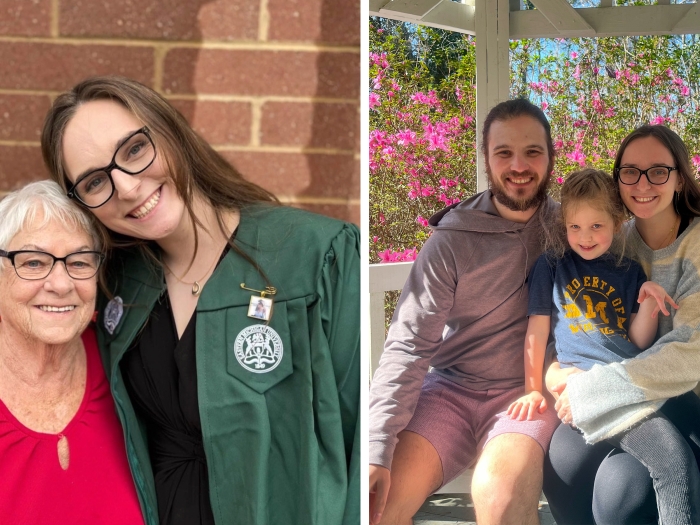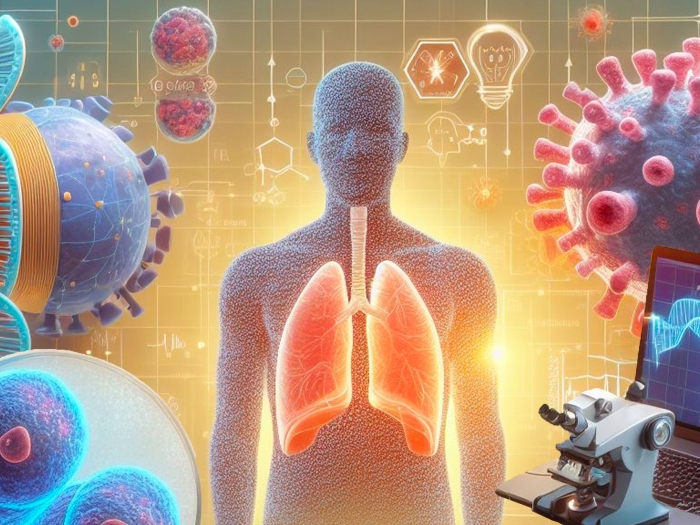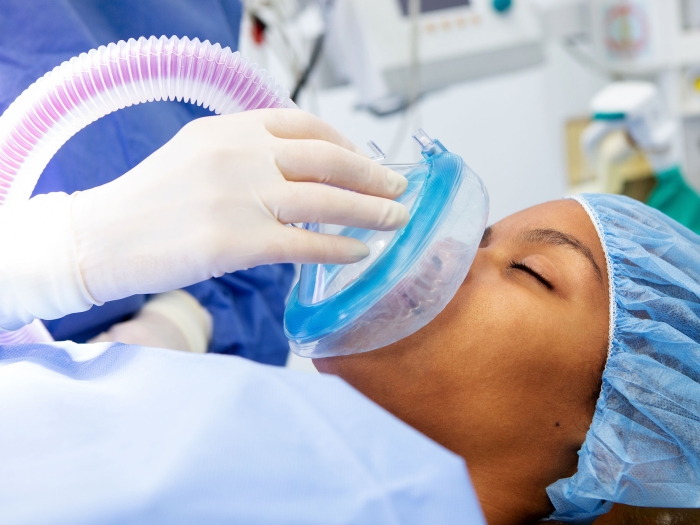Lung cancer screening has been found to reduce deaths from the disease, so why shouldn’t everyone get tested? Michigan Medicine experts explain.
11:00 AM
Author |

This article was updated on November 10, 2020.
A person has a CT scan that found a spot on one of her lungs. Could it be cancer? Sometimes, the only way to know is a biopsy.
But during the biopsy, one of her lungs collapses — a serious complication. She recovers, and it turns out the spot wasn't cancer after all.
Now a second patient has a spot on the lung. This one is cancer.
The second patient is the exception to the rule; most spots or "nodules" are not cancerous. But it is stories like the second patient's that make headlines — as do awareness initiatives such as the American Lung Association's "Saved by the Scan."
The ALA advocates for patients, raises funds and promotes lung cancer screening, but it doesn't practice medicine, says Douglas Arenberg, M.D., associate professor of pulmonary and critical care medicine and director of the lung cancer screening program at Michigan Medicine. Such campaigns, he says, can oversimplify the complexity of screening.
"Testing is not health care," Arenberg says. "Testing is determining if you need health care. I am a passionate advocate for screening for lung cancer — but in the right patients."
Who needs lung cancer screening
The U.S. Preventive Services Task Force, the federal government body that evaluates cancer screening tools, recommends lung cancer screening for people ages 50 to 80 who have smoked at least 20 "pack years" — the equivalent of a pack a day for 20 years — and are either current smokers or have quit within the past 15 years. This is based on results of a large national trial that found in a similar group that CT screening, compared to chest X-rays, lowered the risk of dying from lung cancer.
The guidelines were updated in 2020 to reflect new data that found lung cancer deaths were reduced by nearly 25% among current and former smokers through the use of regular, low-dose CT screening.
The ramifications of tobacco are clear. Lung cancer is by far the leading cancer killer. More than 135,000 Americans die of the disease every year, according to the American Cancer Society. That's more than cancers of the colon, breast and prostate combined.
"The lung is the great filter of everything you breathe," says Ella Kazerooni, M.D., professor of radiology at Michigan Medicine and chair of the American College of Radiology's Lung Cancer Screening Committee.
Even coughs or colds affect what you see on a computed tomography or CT scan. So if you plan to allow something as invasive as a biopsy, you should know the implications.
"The first thing I ask a patient is, 'What do you know about lung cancer screening?'" Arenberg says. "Usually, the answer is a blank stare."
As for primary care physicians, they may not know who would benefit most from lung cancer screening. "Doctors find some guidelines confusing and some conflicting," Arenberg says. "It's one more expectation to add to their plate."
Says Kazerooni, "We don't have the pink-ribbon awareness associated with breast cancer. It's harder for physicians to go through the pros and cons."
As a result, doctors often overestimate the benefits and underestimate the risks of screening, Arenberg says.
He recalled a patient from a few years ago who was screened for lung cancer and then came in for a $6,000 PET scan to look for lung cancer. The patient entered the office in a wheelchair, on oxygen, weighing around 350 pounds and unable to walk across the room.
Given all these complicating factors, it is reasonable to say this patient should not be screened, Arenberg says.
Another problem is the lack of understanding on the part of some patients whom Arenberg refers to as "the worried well."
"They think that screening has an almost mythical protective factor," he says. "If doctors don't understand it, then how can we expect patients to?"
Testing is not health care. Testing is determining if you need health care.Douglas Arenberg, M.D.
The downsides to screening
Screening itself is a misunderstood concept, one that goes beyond a single test. Many screenings can be burdensome. A freckle can be harmless, but nonetheless requires months of follow-up.
In the lungs, most abnormalities found by a CT scan are "more often the result of old infections, scar tissue or other causes," according to the ACS.
But this gets lost in the marketing messages promoting screening. You don't hear about the patient whose lung collapses during a biopsy, or the one with other complications during an invasive procedure, or those panicked with worry waiting for a diagnosis that may never come.
The ones who are, in Arenberg's words, "scarred by the scan. Nobody writes those letters," he says, adding, "Data should replace anecdote."
Rafael Meza, Ph.D., associate professor of epidemiology at the University of Michigan School of Public Health, works to share that data.
With his background in biomathematics, epidemiology and risk prediction, he collaborated with Arenberg and others to create a tool for potential patients to use as they search online: ShouldIScreen.com.
The goal was to create something that could help individuals learn about screening, its pros and cons, and help them measure their cancer risk. At the same time, Meza says, "We wanted to make sure the message could be tailored to the individual." A Spanish version of the site is also available.
And the data is refined all the time. "These things are not static," says Meza, who also runs a research program that looks at policies to prevent lung cancer. New guidelines and recommendations to interpret the results of screening have been put in place to minimize the rates of false positives and improve the value of screening. So hopefully screening in practice will work even better than the way it did in the clinical trials.
The website may be directed toward patients, but it is no substitute for the doctor-patient relationship.
Lung screening requires shared decision-making, Kazerooni says. Often that takes a 30-minute discussion with a doctor. But what if your doctor sees a new patient every 15 minutes?
SEE ALSO: Thriving After Lung Cancer, Thanks to a Clinical Trial
"The time that doctors have with patients to discuss everything is limited," Arenberg says.
Among discussion points are the very definition of screening, as well as its limits.
The two sides of screening
"Some doctors really believe in screening almost everybody for lung cancer. They say, 'if there's any chance to detect cancer early, we should take that.' But that approach ignores the downside to screening," says Tanner Caverly, M.D., assistant professor of learning health sciences and internal medicine at Michigan Medicine. Caverly and Meza authored a study on how to identify the right patients for lung cancer screening.
On the other side of the debate are the screening skeptics.
"Our group is in the middle," Caverly says. "The best evidence shows that lung cancer screening has incredible benefits for some patients — those with very high lung cancer risk who are still reasonably healthy otherwise. For others at lower risk or who are less healthy, lung cancer screening probably should be controversial."
In talking about lung cancer screening, he reiterates the phrase "personalized approach."
"One of the barriers is doctors have to find the time to do the work to personalize things like cancer screening," he says. "To me, the strongest benefit is trying to tailor decisions to the individual patient. We want to avoid treating patients like a number."
Kazerooni, who was intricately involved in the National Lung Screening Trial and subsequent efforts to establish guidelines for lung cancer screening, compares lung cancer screening with the 30-year path of the mammogram. The number of people currently reached for CT scans is "in its infancy," she says. Lung cancer screening may be reaching 1 million out of 8 million to 10 million people eligible.
The American College of Radiology's Lung Cancer Screening Registry, which opened in 2015, will help answer questions about screening, she says. "As we are starting to aggregate data, we're starting to improve."
Ultimately, in an era of ever-more sophisticated and ever-more technological medicine, along with ever-more nuanced diagnoses, the best preventive measure for lung cancer remains the simplest of all, notes Arenberg.
"All of this is meaningless unless we get people to stop smoking."
Learn more about Michigan Medicine's Lung Cancer Screening Clinic.

Explore a variety of healthcare news & stories by visiting the Health Lab home page for more articles.

Department of Communication at Michigan Medicine
Want top health & research news weekly? Sign up for Health Lab’s newsletters today!





